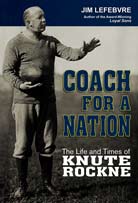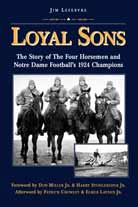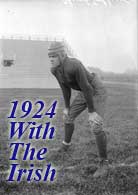Notre Dame’s first consensus national championship was earned by a team whose place in college football history and lore was forever immortalized by the achievements – and subsequent publicity – of the famous Four Horsemen. Quarterback Harry Stuhldreher, halfbacks Don Miller and Jim Crowley, and fullback Elmer Layden combined to form a unit which dazzled opponents with its speed, deception, versatility and coordination. Operating out of Coach Knute Rockne’s Notre Dame shift, any of the four might be the ball carrier, passer, receiver or kicker on any given play. Guiding the way was the line, dubbed the Seven Mules, led by captain and All-American center Adam Walsh. All 11 regulars were seniors, as were a large number of the second unit, also known as the Shock Troops, which started most games and acted as “shock absorbers” of the opponents’ initial energy, wearing them down before the Horsemen and Mules took over.
Over their three-year varsity careers, the ’24 seniors compiled an overall record of 27-2-1, losing to only one other team, in games at Nebraska in 1922 and 1923. Coming into the 1924 season, the backfield was well-established, but it took some retooling to arrive at a stable front line. Once assembled, they raced to football immortality. On October 18, 1924, in the annual grudge match with Army, the Irish dominated play for long stretches of a 13-7 victory. Grantland Rice, the nation’s top sportswriter, whose column appeared coast to coast, led his game report with the famous words,
“Outlined against a blue-gray October sky, the Four Horsemen rode again. In dramatic lore they are known as Famine, Pestilence, Destruction and Death. There are only aliases. Their real names are Stuhldreher, Miller, Crowley and Layden. They formed the crest of the South Bend cyclone before which another fighting Army football team was swept over the precipice at the Polo Grounds yesterday afternoon as 55,000 spectators peered down on the bewildering panoroma spread of the green plain below.”
Notre Dame followed with impressive victories over top teams from the East (Princeton), South (Georgia Tech) and Western Conference (Wisconsin), before hosting the nemesis from the Plains (Nebraska). Before a record crowd at Cartier Field, the Four Horsemen ran wild, downing the Huskers 34-6 while outgaining them by a whopping margin of 465 yards to 56. Now, across the land, football fans marveled at Rockne’s “Wonder Team.” The nickname “Four Horsemen” gained wide use, and a publicity photo of the four mounted on workhorses was picked up by newspapers from coast to coast. Victories over Northwestern – in the first major football game at what we now call Solider Field – and Pittsburgh’s powerful Carnegie Tech concluded the regular season.
What followed is a bowl trip never duplicated before or since. The Irish went on a three-week odyssey to and from the Jan. 1, 1925 Rose Bowl in Pasadena, Calif. In cities from Memphis to New Orleans to Houston to Tucson, and back via San Francisco, Denver, Salt Lake City and Lincoln, the Irish were hailed as the nation’s top team, and drew huge crowds of proud, predominantly Catholic onlookers…almost all of whom became Notre Dame fans for life. The national outpouring for the humble sons of Our Lady’s University set the stage for a coast-to-coast following that remains today.
As for the Rose Bowl itself, the Irish were tested mightily by undefeated Stanford, coached by Hall of Fame Pop Warner and featuring the great triple-threat back Ernie Nevers. The game was played before a capacity crowd in the two-year-old stadium, and broadcast via repeater station across the country, becoming the first truly national sports broadcast. The game turned on two Nevers passes that were intercepted by a leaping Layden and returned for ND touchdowns, and ND prevailed, 27-10. The Irish became the first football team to play games in New York City, Chicago and southern California in the same season, and finished with 10 wins and no losses.
For the complete story of the 1924 championship season, order your copy of “Loyal Sons: The Story of The Four Horsemen and Notre Dame Football’s 1924 Champions.”






